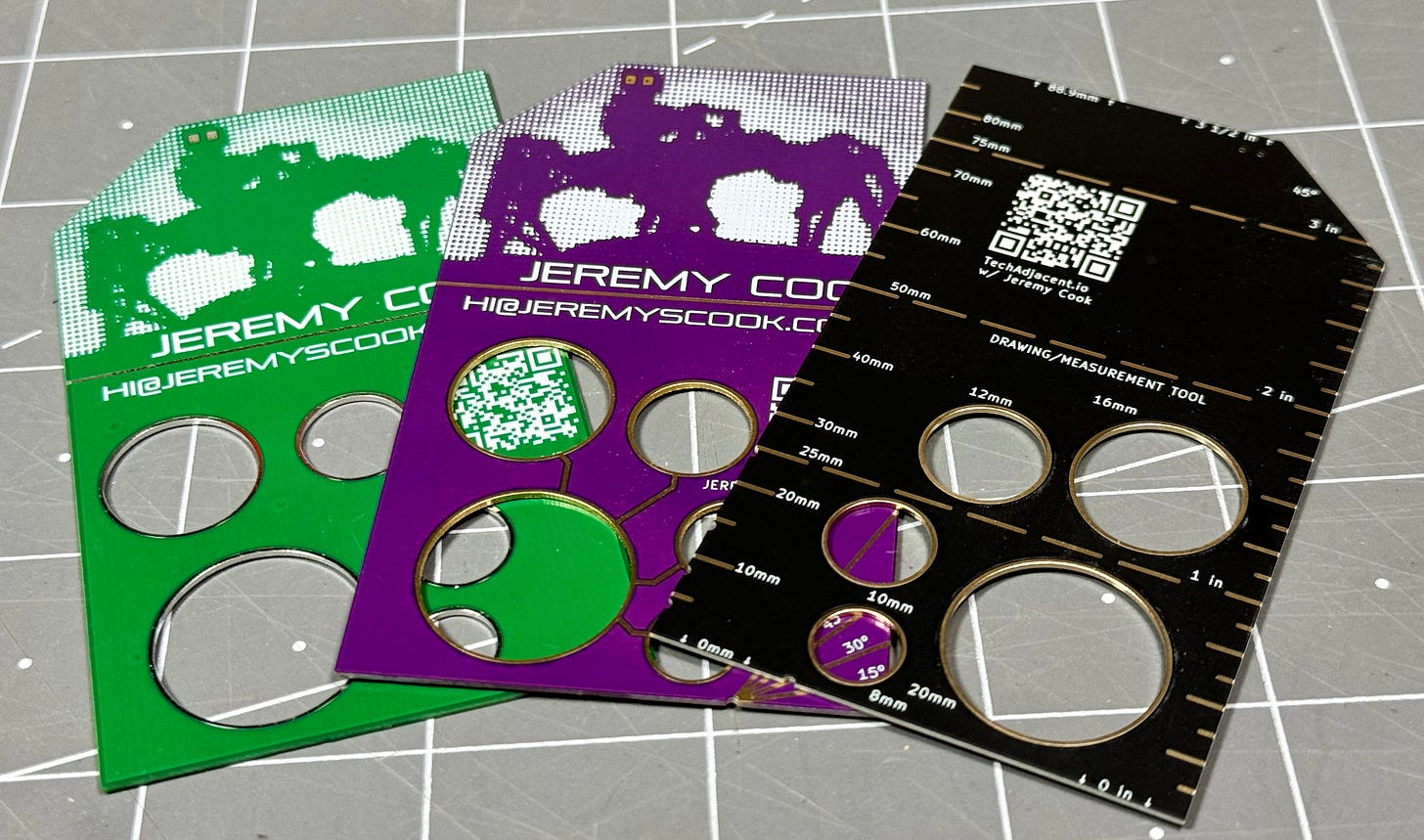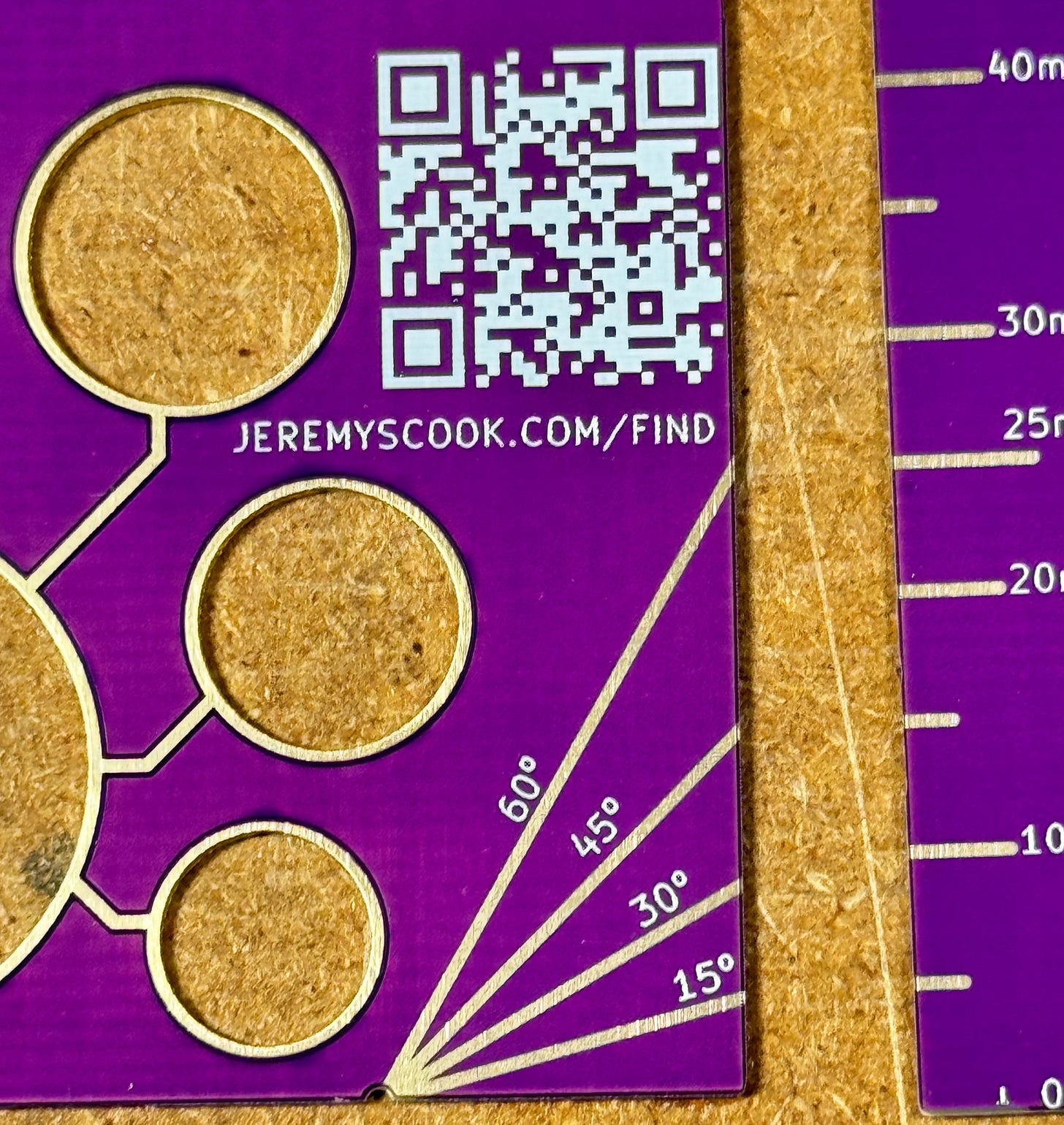The Perfect PCB Business Card
The perfect printed circuit board business cards: Inexpensive, beautiful, functional drawing/measurement tools [Questionable Use Case #7]
Waaay back in February 2025, I outlined how you can make artistic designs on circuit boards, highlighting a few of my favorites.1 But where does the world of art end and the realm of practicality begin?
I definitely see engineering as art, and–if I may brag just a tiny bit–I’ve made a number of machines and designs that I consider to be beautiful. But if we have to draw the line somewhere, the humble business card is perhaps the perfect art/functional tool demarcation.
Business cards are extremely functional (i.e. how do you find this person?), and normal directors and VPs may also pride themselves in a business card’s art: typography, eggshell coating, or even watermarks.2 However, if you’re an engineer, such cards may seem rather boring. To express your techno-prowess, why not design your own on a printed circuit board (PCB)?
Below are two PCB-based designs that I came up with. The right contains actual circuitry and can light up (with an LED/battery applied), while the left requires no components and acts as a drawing tool (iterated upon in the purple/black versions above). Both have inch/metric scales on the back for impromptu measurements.
Business Card PCB Requirements
With each iteration, my cards hopefully get better and better. But how does one define better in this case? Below are my artistic/design ideals for of a PCB business card:
Info (how to get in touch) - I say keep this simple, perhaps referencing a contact page on your website (that isn’t going to change). QR codes are great, given our near-ubiquitous access to smartphones.
Cheap enough to distribute - If it takes you significant time and/or expense to make your PCB cards, you’re not going to want to give them away freely. $1–ideally well under–is a good goal. This is very difficult if you’re adding microcontrollers and other electronics components to the mix.3
Fit in your wallet - You need to be able to keep these with you ~at all times. .8mm PCBs fit nicely in a wallet. You can sort of get away with slim surface-mount components, but anything thicker is a no-go. My light-up card, shown in-action below, is slim and interesting, but even its one little LED component and battery were kind of a hassle.
Space/color for notes - Often when I give away one of these cards I will include a little note, like “Thx - JC” in the unmarked area on the back. So a bit of blank space is a feature, not a bug. Marker doesn’t show up as well on my matte black “PCBusiness” card shown below versus green or purple, but the card itself does look sharp.
Make it useful and/or interesting enough to keep - When I first started working, I thought collecting business cards was cool, but the novelty soon wore off. However, if you get really creative with your PCB-card, you might make something useful enough for people to keep at arm’s length, e.g. a drawing and measurement tool–or even a flashlight!

PCB Business Card Vendor Differences
I’ve used PCBWay and JLCPCB for my cards so far. Both do a very good job, though JLCPCB tends to be less expensive, and the seem to have some advantages when it comes to PCB assemblies (PCBAs–if you want to get into that world).
Green solder mask4 tends to be the most standard/cheapest color, so certainly best for the “cheap enough to distribute” requirement. I went a little wild and tried out JLCPCB’s purple (shown below), along with PCBWay’s excellent matte black solder mask (shown in the first image on this page and in the video). I’m using gold ENIG contacts (oooooo!) on both the purple and black versions.5
Both matte black/ENIG (PCBWay) and purple/ENIG (JLCPCB) look way better than green IMO, and are probably worth paying a bit extra for. That being said, marker notes show up better on purple (though still visible on matte black), so perhaps that color is slightly better.
In my very specific case, I’d also give a 👍 to adding actual eye holes in the middle of the rectangular gold/ENIG sections above. This makes things more expressive, and way more obvious that they are robot eyes.
PCB business cards resources
If you want to make your own PCBusiness cards, there’s a bit of information you’ll need to absorb:
Take the Plunge Into PCB Design - You’ll need to get started somewhere. How I started down this path with KiCad several years ago.
PCB Layers Explained - PCB layers are typically used for practical purposes, i.e. moving electrons around. You’ll need some understanding of what’s going on to create the proper effect for your business card.
Add a QR code to your KiCad PCB design - so useful for business cards. Note that the ~14mm QR codes on my latest cards show up nicely, but bigger is obviously better. Also, the longer your URL, the more bits that need to be packed in, so keep it short if possible. (i.e. techadjacent.io > techadjacent.substack.com
PCBs as Beautiful Art - previous post here on Tech Adjacent. Inspiration?
Or just search around. You’ll find lots of other resources. OTOH, if you don’t want to design your own PCB business card, but would like one to distribute and show off to your friends, get in touch: hi@jeremyscook.com and we can talk!
You want card? You want subscribe? You want share?
Do you want one of my cards? If so, leave a comment with your request on the article, or email me: hi@jeremyscook.com and I’ll see what I can do.6 Of course, another great way to stay in touch is to subscribe to this very newsletter/blog/substack/ via the 👇 button thingy:
OR if you want to forward this on to a friend/family member/enemy/stranger that you think would like it, that would be awesome. Go ahead. They won’t mind (Maybe). -JC
Thanks for reading! I hope you will follow along as I post weekly about engineering, technology, making, and projects. Fair warning: I am a native Florida man, and may get a little off-topic in the footnotes.
Note that any Amazon links are affiliate
Addendum/Footnotes:
A few of my favorites, that is, from replies I got on a certain BSKY thread. I’m well aware that there is MUCH more out there, some of which is certainly quite good, and some of which I haven’t even seen 👇
Circuit Boards as Art! 🎨 [Questionable Use Case #4]
Several posts ago, I announced my Coaster Transistor Diagram PCB (Printed Circuit Board) on Kickstarter, which is still funding for a while longer if you want to check it out. Or Czech it out if you live here.
While other VPs may have cards with a watermark or custom lettering, few can match the power of a custom-designed .8mm PCB business card. And yes, I am president of Jeremy Cook Consulting LLC.
Thx to friend and fellow pineapple master dilettante Jason D for the tip on this one. I’ve never actually seen American Psycho… Upon further pre-production discussion, Jason tells me that he’s only seen this movie once, and insists that he did not tell me about this scene.
Well, whoever showed me this, thanks. Given the movie’s title and subject matter, it’s a bit disturbing if I’m having some sort of fugue state related to this bit of information.
OTOH, if you really want to impress someone, an expensive card could be well worth it, but might also lead to awkward situations when you maybe want to give it to one person, but not someone else.
Solder mask, AKA the main color of the PCB for our purposes here.
PCBWay has sponsored my YouTube videos on several occasions, but did not sponsor these particular boards.
“Matte black” appears to be a PCBWay exclusive (or at least not readily available via JLCPCB) and is their “killer app” IMO.
If the USPS decides that it doesn’t like these in normal envelopes, then all bets are off. PCBs are made an a version of fiber glass a la paper, and it’s literally a printed circuit board, so I think there is a good argument to be made for these being documents.






![Circuit Boards as Art! 🎨 [Questionable Use Case #4]](https://substackcdn.com/image/fetch/$s_!yns4!,w_1300,h_650,c_fill,f_auto,q_auto:good,fl_progressive:steep,g_auto/https%3A%2F%2Fsubstack-post-media.s3.amazonaws.com%2Fpublic%2Fimages%2F9d527676-131b-4372-8c40-41f497dda0c9_1356x968.png)
If fiberglass is "paper" then so is your road bike with the carbon-fiber frame, so I don't think that dog will hunt. Sorry, calls 'em like I sees 'em.
The creativity that goes into even thinking about replacing boring old business cards with something useful is absolutely inspiring to me. Thanks for sharing!